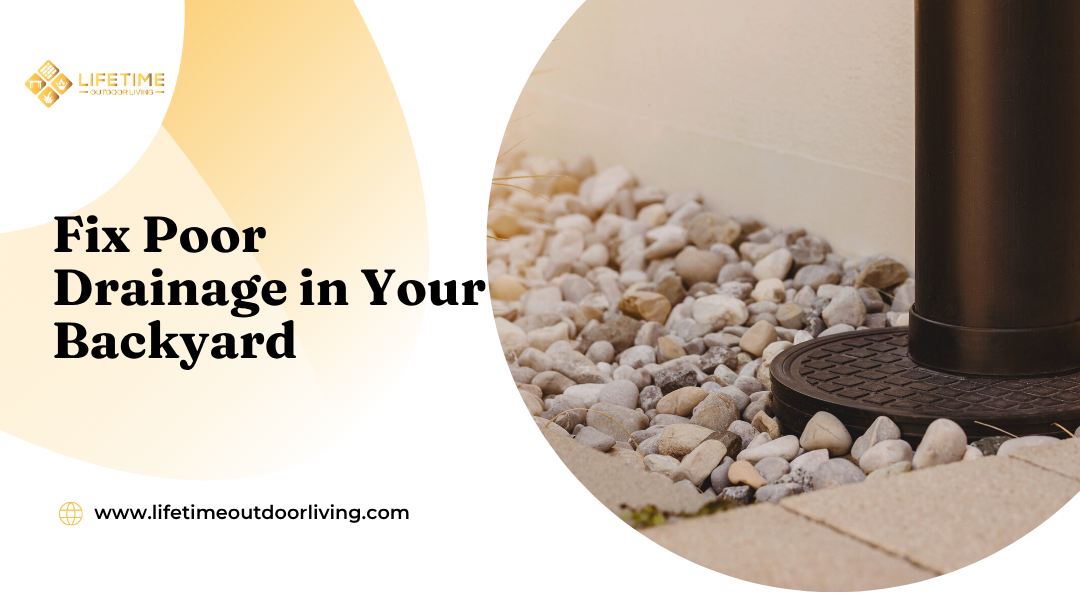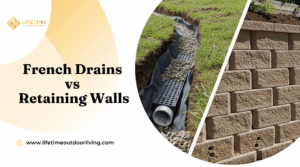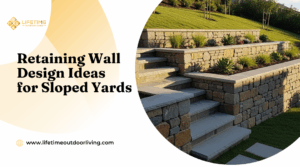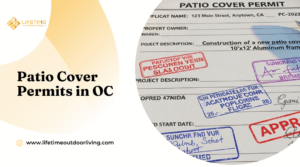Poor drainage in a backyard can quickly turn an enjoyable outdoor space into a muddy, unusable area. The most effective way to fix poor drainage without ruining the landscape is to install proper grading and drainage systems that direct water away from problem spots while preserving the yard’s natural look. This approach prevents water pooling and damage while maintaining the beauty of your outdoor environment.
Lifetime Outdoor Living specializes in creating functional, attractive outdoor spaces in Laguna Beach and the Orange County area. Their expertise allows them to address drainage issues with solutions like French drains, dry wells, or regrading that integrate seamlessly into existing landscapes. By working with professionals, homeowners avoid common mistakes that can worsen drainage or harm their outdoor design.
Choosing a company like Lifetime Outdoor Living ensures that drainage fixes enhance rather than detract from the backyard’s appeal. Their focus on quality materials, customized plans, and skilled installation means the yard remains both beautiful and usable, even after correcting water problems.
Causes of Backyard Drainage Problems
Backyard drainage issues often stem from natural land features, improper landscaping decisions, or hidden sources of water flow. Recognizing these specific causes helps target effective and practical solutions without damaging the existing landscape.
Natural Terrain Challenges in Laguna Beach
Laguna Beach’s coastal location contributes to unique terrain factors that affect drainage. The hilly topography creates slopes where water runoff can concentrate, causing erosion and pooling in lower areas.
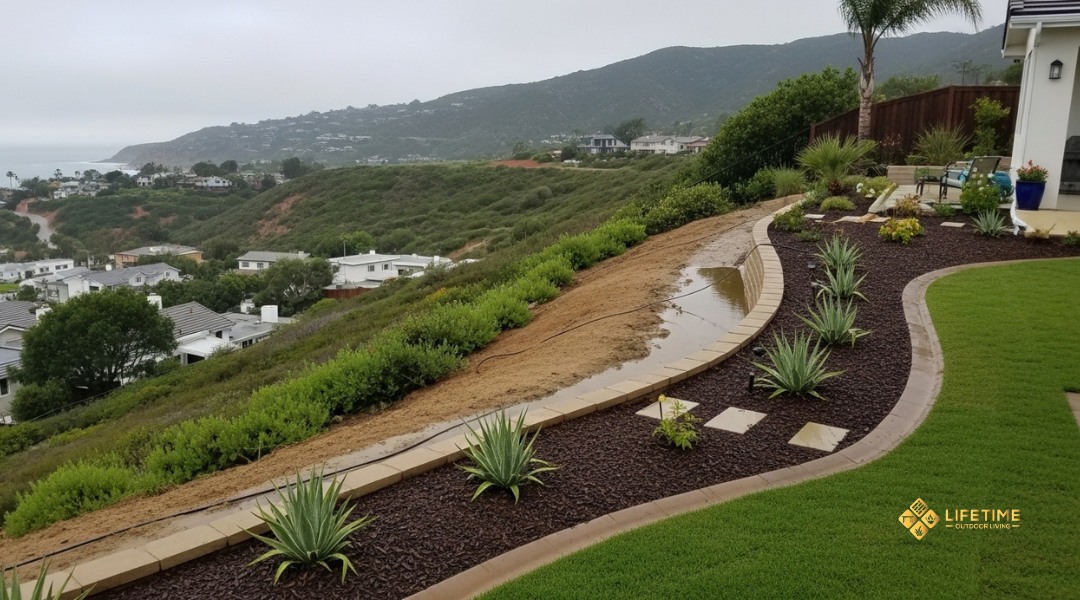
The soil composition often includes clay and compacted earth, which limit water absorption and increase surface runoff. This leads to standing water after heavy rainfalls.
Salt content and proximity to the ocean can also affect soil permeability and plant health, further complicating natural drainage patterns in backyards.
Common Drainage Mistakes in Landscape Design
Incorrect grading is a frequent error. Backyards that slope toward a home or flat areas without a clear outlet encourage water collection.
Using impermeable materials like dense concrete without proper drainage channels blocks natural water flow. Irrigation systems that release too much water exacerbate saturation in problem spots.
Poorly placed downspouts or the absence of rain gutters can dump excess water near the foundation, worsening drainage. Lack of a comprehensive drainage plan often results in temporary fixes that don’t address root causes.
How to Identify the Source of the Problem (Not Just the Symptoms)
Pinpointing the drainage source requires observation during and after rainfall. Identifying where water enters, moves, and accumulates is critical.
Look for signs like soil erosion, long-lasting puddles, and plant health decline. Mapping water flow paths helps distinguish between surface water issues and possible underground blockages.
Testing soil infiltration rates in different parts of the yard can reveal compacted zones. Consulting drainage experts ensures a proper diagnosis beyond visible symptoms.
Signs Your Backyard Has Drainage Issues
Drainage problems show in specific, observable ways that affect your yard’s usability and health. These signs include water accumulation, soil displacement, damage to structures, and unhealthy plants.
Standing Water or Soggy Patches After Rain
If water pools on the surface hours after rainfall, it indicates poor drainage. These standing puddles create soggy areas that don’t dry quickly, making lawn use difficult.
Persistent wet spots can lead to mosquito breeding and damage grass roots. This reduces turf vitality and can cause muddy or slippery surfaces where people walk.
Regularly check areas where water collects to identify blockages or soil compaction causing slow absorption. Proper drainage prevents water from lingering and protects outdoor spaces.
Soil Erosion or Exposed Tree Roots
Soil erosion appears as bare patches or uneven ground where topsoil washes away during storms. This loss of soil weakens plant stability and exposes tree roots.
Exposed roots often indicate excess surface water flow, which removes protective soil layers. This can stress trees and lead to root damage or decay.
Look for signs like gullies or channels formed by running water. Controlling erosion involves redirecting water flow and reinforcing soil with vegetation or barriers.
Cracked Pavement or Foundation Shifting
Cracks in concrete, asphalt, or stone surfaces near the home suggest water-related foundation issues. Poor drainage causes soil to expand or contract, unsettling paved areas.
This movement can lead to uneven walkways, patios, and driveways, posing tripping hazards and accelerating surface wear. Foundation shifting risks structural damage inside the house as well.
Early detection of pavement cracks near downspouts or low spots allows for timely drainage fixes. Addressing underlying water problems extends pavement lifespan and home safety.
Poor Plant Growth or Rotting Garden Beds
Plants struggling to grow or dying in certain spots may suffer from too much water. Constant saturation deprives roots of oxygen, leading to rot and poor absorption of nutrients.
Garden beds with persistent wet soil develop fungal diseases that kill vegetation. Plants that wilt or show yellowing leaves in low-lying areas signal drainage failure.
Assess soil moisture and root health in affected areas. Improving drainage reduces waterlogged soil and promotes stronger, healthier plants across the landscape.
Smart Drainage Solutions That Preserve Landscape Aesthetics
Effective drainage methods can manage water without compromising the visual appeal of a backyard. There are solutions that integrate with existing landscapes and enhance their natural beauty while preventing water issues.
French Drains: Subtle, Effective, and Invisible
French drains consist of a trench filled with gravel and a perforated pipe that redirects water away from problem areas. Installed below ground, they remain out of sight and do not disrupt the surface landscaping.
They are especially useful for managing excess water around foundations or low spots. Proper placement and slope ensure efficient drainage, protecting plants and hardscapes without altering the yard’s look.
Maintenance is minimal but important. Occasional flushing keeps pipes clear, making French drains a long-lasting drainage solution that blends into any backyard.
Dry Creek Beds: Functional Drainage with a Natural Look
Dry creek beds are shallow channels lined with decorative rocks or pebbles that guide runoff water. They function like natural streams, moving water away without flooding or erosion.
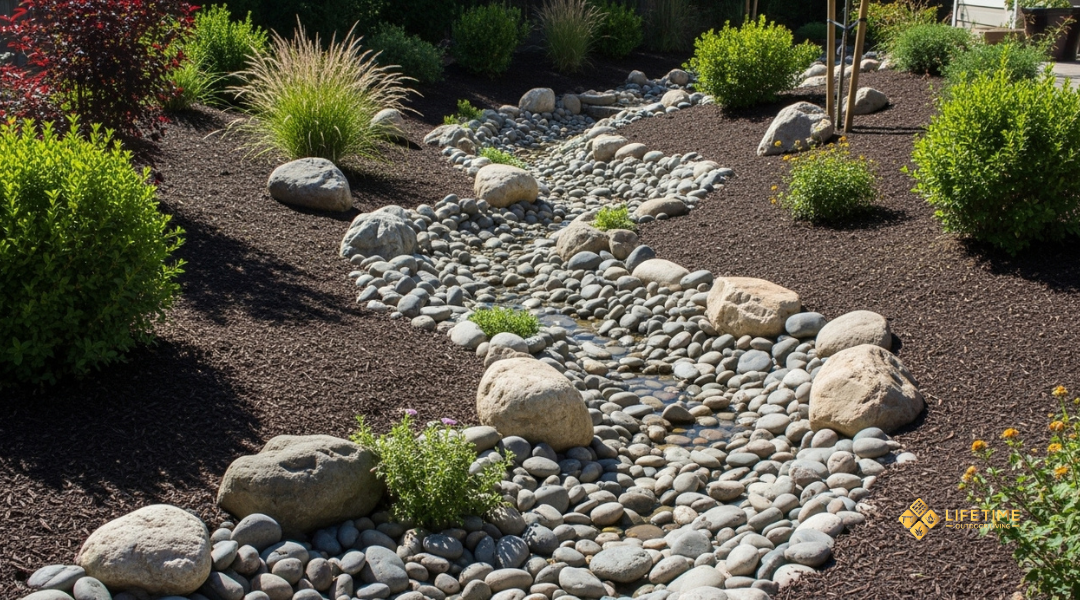
This method mimics natural water flow and adds texture and interest to the landscape. It also provides a practical solution for yards with sloping terrain, helping to control water at specific points.
Plantings around the bed, like drought-resistant shrubs, soften the look further. Dry creek beds require little upkeep and avoid standing water issues that attract pests.
Rain Gardens: Turning Water Trouble Into a Design Feature
Rain gardens use deep-rooted native plants in shallow depressions to absorb excess rainwater. These gardens slow runoff and promote infiltration, reducing strain on drainage systems.
They offer a green, visually appealing alternative to traditional drainage. Choosing plants adapted to wet conditions ensures lifespan and effectiveness.
By capturing rainwater, they minimize erosion and filter pollutants. This eco-friendly solution also supports local wildlife, adding environmental value beyond drainage.
Permeable Pavers: Beauty and Drainage in One
Permeable pavers are designed with gaps or porous materials that allow water to pass through, reducing surface runoff. They combine the strengths of traditional paving with effective drainage.
These pavers can be used on patios, driveways, and pathways without sacrificing style. Their variety in shapes, colors, and textures lets homeowners maintain design continuity.
Maintaining permeability involves cleaning joints and preventing clogging. Permeable pavers offer a durable option for managing water while enhancing hardscape aesthetics.
How to Fix Drainage Around Patios, Walkways, and Driveways
Properly managing water near hardscapes prevents pooling that can cause damage or safety issues. Addressing drainage involves strategic installation, reshaping surfaces, and maintaining existing structures to ensure water moves away efficiently.
Installing Channel Drains and Grates
Channel drains are narrow troughs installed along edges of patios, walkways, or driveways to capture runoff. They connect to underground pipes that carry water away from the property.
Choosing the right size and material for grates is important for durability and debris control. Metal grates offer strength for driveways, while plastic or composite grates suit lighter traffic areas.
Installation requires digging trenches at the lowest points, ensuring a slight negative slope so water flows freely. Proper sealing between the channel drain and existing surfaces prevents leaks into the foundation.
Grading Hardscapes to Redirect Water Flow
Grading means adjusting the slope of patios or walkways to direct water away from structures. A minimum slope of 1-2% away from the home is standard for effective drainage.
This can involve adding or removing soil under the hardscape base. Re-grading also prevents water pooling by creating smooth, consistent slopes.
For driveways, side slopes direct water toward drainage swales or inlets. Uneven surfaces should be leveled or repaired to avoid traps where water collects.
Sealing and Repairing Existing Cracks
Cracks in concrete or pavers allow water to seep underneath, causing erosion and base weakening. Sealing these cracks stops water infiltration and prevents further damage.
Use appropriate sealants, such as polyurethane or epoxy, based on the crack width and material. Small cracks can be filled with caulk or filler, while larger gaps may require patching compounds.
Regular inspection and timely repairs extend the lifespan of hardscapes and maintain effective drainage by ensuring the surface remains intact.
Choosing the Right Plants and Landscaping Features
Selecting plants and landscaping elements that suit both wet and dry conditions is key to managing backyard drainage effectively. Features like raised beds and mulch help control erosion while supporting healthy soil. Designing the layout to work with natural water flow prevents damage and encourages proper drainage.
Native Plants That Thrive in Wet/Dry Cycles
Native plants adapted to Laguna Beach’s climate tolerate fluctuating moisture levels better than exotic species. Plants like California fuchsia, monkey flower, and blue-eyed grass absorb excess water without drowning. Deep-rooted natives stabilize soil and reduce runoff by improving infiltration.
Choosing drought-tolerant as well as flood-tolerant varieties creates balance in wet and dry seasons. Plants should be grouped by their water needs to avoid overwatering or water stress. This reduces the chance of landscape damage and maintenance headaches.
Raised Beds, Mulch, and Ground Covers to Combat Erosion
Raised beds lift plants above soggy soil, preventing root rot and improving drainage in problem areas. They also direct water flow away from plant roots. Applying 3–4 inches of mulch conserves moisture while reducing soil erosion.
Ground covers like creeping thyme, ajuga, and native grasses protect bare soil and absorb water. They act as a natural barrier against runoff. Combining these features slows water speed, reduces displacement, and preserves topsoil.
Designing With Water Flow in Mind (Not Against It)
Planning landscape contours to guide water naturally avoids pooling and damage. Contouring soil to slope gently away from structures encourages proper drainage. Features like swales or dry creek beds channel excess water to desired areas safely.
Using permeable paving materials allows water to soak through rather than run off hard surfaces. Positioning plants and beds along water flow paths maximizes absorption. Integrating these principles minimizes erosion and maintains landscape integrity.
Professional Drainage Fixes That Blend With Your Yard
Effective drainage solutions must address water flow without damaging the existing landscape aesthetics. These fixes should be tailored, durable, and require manageable upkeep to ensure long-term performance.
Customized Solutions from Lifetime Outdoor Living
Lifetime Outdoor Living evaluates the unique layout, soil type, and slope of each property. They design drainage systems such as French drains, dry wells, or surface grading that integrate seamlessly with patios, gardens, and walkways.
Materials and placements are selected to preserve natural beauty and maintain outdoor usability. The team uses high-quality piping and gravel that promote efficient water redirection without visible disruption. Clients receive solutions specific to Laguna Beach’s climate and property conditions.
Why DIY Isn’t Always the Best for Long-Term Drainage
While DIY projects can address minor drainage issues, they often lack precision in slope measurement and material selection. Improper installation can result in erosion, standing water, or damage to hardscapes.
Professional drainage fixes consider factors like soil permeability and local rainfall patterns. Without this knowledge, DIY attempts risk recurring problems, causing higher long-term costs. Experts also ensure drainage complies with local codes, preventing future property disputes.
How to Maintain the Fix Without Constant Upkeep
Maintenance focuses on clearing debris from gutters, drains, and surface channels regularly. Lifetime Outdoor Living recommends seasonal inspections to catch blockages or erosion early.
Simple steps include removing leaves, monitoring soil settling near drainage points, and verifying that pipes remain unobstructed. These actions prevent minor issues from worsening and reduce costly repairs or redesigns.
A well-designed drainage system by professionals minimizes the need for ongoing intervention, saving time and effort for homeowners.
Bonus: Preventing Future Drainage Problems Before They Start
Proper maintenance and thoughtful planning are essential to avoid drainage issues in the backyard. Early detection and careful design reduce costly repairs and protect the landscape’s integrity.
Routine Inspection Tips for Homeowners
Homeowners should regularly check low spots where water tends to collect after rain. Inspect gutters and downspouts to ensure they are clear and directing water away from the house foundation.
Look for signs such as soggy soil, standing water, or erosion. These indicate drainage problems before they worsen. Keep an eye on soil compaction and grade shifts that can alter water flow over time.
Mounting a simple inspection schedule, like monthly checks during rainy seasons, helps catch issues early. Cleaning debris from drains and gutter guards can prevent blockages and water overflow.
Smart Design Choices During New Landscape Projects
Choosing the right plants and materials improves drainage naturally. Drought-tolerant and deep-rooted plants absorb more water, reducing runoff. Avoid dense, shallow root systems in wet areas.
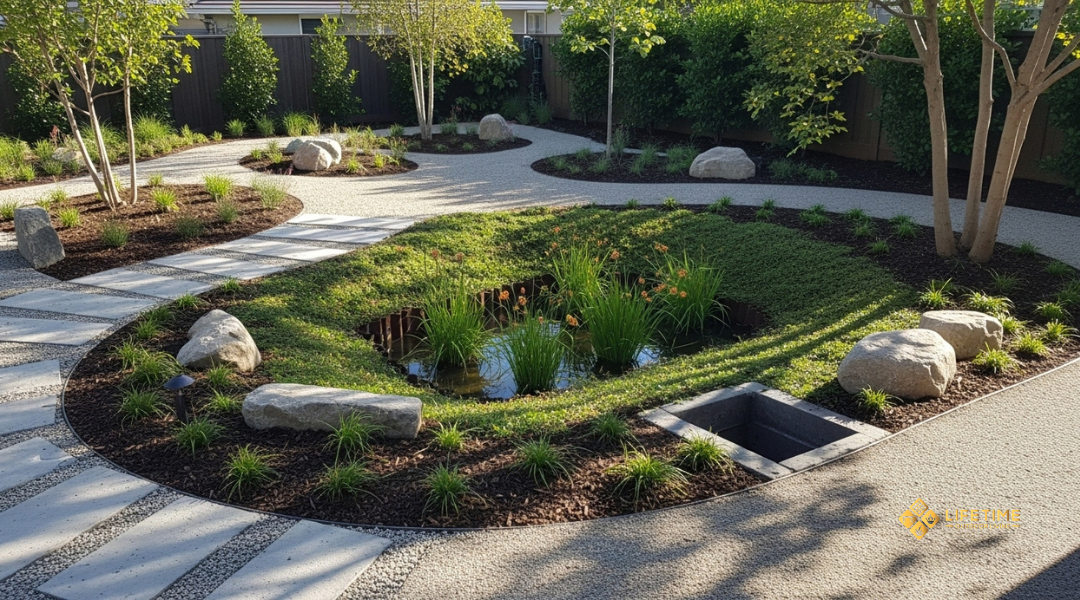
Incorporate proper grading so water slopes away from critical structures. Smooth slopes between 1% and 2% are generally effective. Use permeable pavers or gravel for walkways to allow water infiltration.
Installing rain gardens or dry wells provides targeted areas for excess water. These features trap and slowly release water, lessening strain on drainage systems in heavy rain.
Integrating Drainage Into Every Element — from Grass to Gravel
Each part of the yard should support effective water movement. Lawns with compacted soil can be aerated to increase absorption. Avoid overwatering to prevent saturation.
Gravel beds and mulch layers act as natural filters and slow water runoff. Position these strategically around patios, driveways, and foundation edges. Ensure gravel basins have an adequate slope.
Drainage pipes and channels should connect seamlessly with landscaping elements. Avoid blocking natural water paths with hardscape features. Proper integration avoids water pooling and erosion beneath surface materials.
Why Choose Lifetime Outdoor Living for Drainage Solutions in Laguna Beach
Lifetime Outdoor Living addresses drainage problems with precise expertise tailored to Laguna Beach’s unique environment. Their ability to combine drainage repair with landscape preservation and design makes them an efficient, all-in-one solution.
Local Experience with Coastal and Hillside Properties
Lifetime Outdoor Living understands the specific drainage challenges posed by Laguna Beach’s coastal proximity and hillside terrain. These areas often face issues like soil erosion, water runoff intensity, and saltwater corrosion. The company leverages detailed local knowledge to design solutions that withstand these conditions.
They consider factors such as slope gradient, soil type, and regional rainfall patterns. This ensures that drainage systems are not only functional but durable against the local climate and geography. Expertise in working with steep slopes avoids destabilizing vulnerable landscapes and prevents further erosion.
One-Stop Team for Drainage, Hardscaping, and Landscape Design
Lifetime Outdoor Living offers a comprehensive approach combining drainage fixes with hardscaping and landscape design. This means customers do not need to hire multiple contractors. The integration of services allows seamless coordination and consistent quality throughout the project.
They install drainage channels, French drains, and grading adjustments alongside patios, retaining walls, and plant beds. This helps maintain smooth water flow without compromising aesthetic or structural elements. Their team includes specialists in paving, landscaping, and water management, enabling tailored solutions within one project scope.
Our Commitment to Preserving Your Yard’s Beauty While Solving the Problem
The company prioritizes preserving the existing landscape’s beauty during drainage repairs. They avoid removing mature plants or dramatically altering yard layouts whenever possible. Instead, they use minimally invasive techniques and creative design.
Their work balances practical drainage needs with visual appeal, carefully selecting materials and methods that blend naturally into outdoor spaces. This approach minimizes disruption and supports long-term yard health by maintaining natural water cycles and soil stability.

